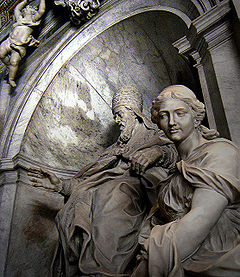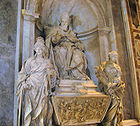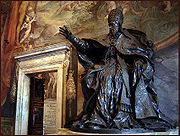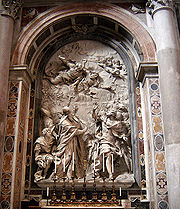
Alessandro Algardi
Encyclopedia

Italy
Italy , officially the Italian Republic languages]] under the European Charter for Regional or Minority Languages. In each of these, Italy's official name is as follows:;;;;;;;;), is a unitary parliamentary republic in South-Central Europe. To the north it borders France, Switzerland, Austria and...
high-Baroque
Baroque
The Baroque is a period and the style that used exaggerated motion and clear, easily interpreted detail to produce drama, tension, exuberance, and grandeur in sculpture, painting, literature, dance, and music...
sculptor active almost exclusively in Rome
Rome
Rome is the capital of Italy and the country's largest and most populated city and comune, with over 2.7 million residents in . The city is located in the central-western portion of the Italian Peninsula, on the Tiber River within the Lazio region of Italy.Rome's history spans two and a half...
, where for the latter decades of his life, he was the major rival of Gian Lorenzo Bernini
Gian Lorenzo Bernini
Gian Lorenzo Bernini was an Italian artist who worked principally in Rome. He was the leading sculptor of his age and also a prominent architect...
.
Early years
Algardi was born in BolognaBologna
Bologna is the capital city of Emilia-Romagna, in the Po Valley of Northern Italy. The city lies between the Po River and the Apennine Mountains, more specifically, between the Reno River and the Savena River. Bologna is a lively and cosmopolitan Italian college city, with spectacular history,...
, where at a young age, he was apprenticed in the studio of Agostino Carracci
Agostino Carracci
Agostino Carracci was an Italian painter and printmaker. He was the brother of the more famous Annibale and cousin of Lodovico Carracci....
. However, his aptitude for sculpture
Sculpture
Sculpture is three-dimensional artwork created by shaping or combining hard materials—typically stone such as marble—or metal, glass, or wood. Softer materials can also be used, such as clay, textiles, plastics, polymers and softer metals...
led him to work for Giulio Cesare Conventi (1577—1640), an artist of modest talents. By the age of twenty, Ferdinando I, Duke of Mantua, began commissioning works from him, and he was also employed by local jewelers for figurative designs. After a short residence in Venice
Venice
Venice is a city in northern Italy which is renowned for the beauty of its setting, its architecture and its artworks. It is the capital of the Veneto region...
, he went to Rome in 1625 with an introduction from the Duke of Mantua to the late pope's
Pope Gregory XV
Pope Gregory XV , born Alessandro Ludovisi, was pope from 1621, succeeding Paul V on 9 February 1621...
nephew, Cardinal Ludovico Ludovisi, who employed him for a time in the restoration of ancient statues.
Tomb of Pope Leo XI
Propelled by the BorgheseBorghese
Borghese is the surname of a family of Italian noble and papal background, originating as the Borghese or Borghesi in Siena, where they came to prominence in the 13th century holding offices under the commune. The head of the family, Marcantonio, moved to Rome in the 16th century and there,...
and Barberini
Barberini
The Barberini are a family of the Italian nobility that rose to prominence in 17th century Rome. Their influence peaked with the election of Cardinal Maffeo Barberini to the papal throne in 1623, as Pope Urban VIII...
patronage, Gian Lorenzo Bernini and his studio garnered most of the major Roman sculptural commissions. For nearly a decade, Algardi struggled for recognition. In Rome he was aided by friends that included Pietro da Cortona
Pietro da Cortona
Pietro da Cortona, by the name of Pietro Berrettini, born Pietro Berrettini da Cortona, was the leading Italian Baroque painter of his time and also one of the key architects in the emergence of Roman Baroque architecture. He was also an important decorator...
and his fellow Bolognese, Domenichino. His early Roman commissions included terracotta and some marble portrait busts, while he supported himself with small works like crucifixes.

Pope Leo XI
Pope Leo XI , born Alessandro Ottaviano de' Medici, was Pope from 1 April 1605 to 27 April of the same year.-Biography:...
, the third of the Medici
Medici
The House of Medici or Famiglia de' Medici was a political dynasty, banking family and later royal house that first began to gather prominence under Cosimo de' Medici in the Republic of Florence during the late 14th century. The family originated in the Mugello region of the Tuscan countryside,...
popes, who had reigned for less than a month in 1605. The monument was started in 1640, and mostly completed by 1644. The arrangement mirrors the one designed by Bernini for the Tomb of Urban VIII (1628-47), with a central hieratic sculpture of the pope seated in full regalia and offering a hand of blessing, while at his feet, two allegorical female figures flank his sarcophagus. However, in Bernini's tomb, the vigorous upraised arm and posture of the pope is counterbalanced by an active drama below, wherein the figures of Charity and Justice are either distracted by putti or lost in contemplation, while skeletal Death actively writes the epitaph. Algardi's tomb is much less dynamic. The allegorical figures of Magnanimity and Liberality have an impassive, ethereal dignity. Some have identified the helmeted figure of Magnanimity with that of Athena
Athena
In Greek mythology, Athena, Athenê, or Athene , also referred to as Pallas Athena/Athene , is the goddess of wisdom, courage, inspiration, civilization, warfare, strength, strategy, the arts, crafts, justice, and skill. Minerva, Athena's Roman incarnation, embodies similar attributes. Athena is...
and iconic images of Wisdom. Liberality resembles Duquesnoy's
François Duquesnoy
François Duquesnoy was a Baroque sculptor in Rome. His more idealized representations are often contrasted with the emotional character of Bernini's works, while his style shows greater affinity to Algardi's sculptures....
famous Santa Susanna, but rendered more elegant. The tomb is somberly monotone and lacks the polychromatic excitement that detracts from the elegiac mood of Urban VIII's tomb.
In 1635-38, Pietro Boncompagni
Pietro Boncompagni
Pietro Corcos Boncompagni was a member of the branch of the historic Jewish Roman family that embraced Christianity, in the person of Solomon Corcos, who in being baptised in 1582 added the family name of Pope Gregory XIII to his own...
commissioned from Algardi a colossal statue of Philip Neri
Philip Neri
Saint Philip Romolo Neri , also known as Apostle of Rome, was an Italian priest, noted for founding a society of secular priests called the "Congregation of the Oratory".-Early life:...
with kneeling angels for Santa Maria in Vallicella
Santa Maria in Vallicella
Santa Maria in Vallicella, also called Chiesa Nuova, is a church in Rome, Italy, which today faces onto the main thoroughfare of the Corso Vittorio Emanuele...
, completed in 1640. Immediately after this, Algardi produced an interactive sculptural group representing the beheading of Saint Paul
Paul of Tarsus
Paul the Apostle , also known as Saul of Tarsus, is described in the Christian New Testament as one of the most influential early Christian missionaries, with the writings ascribed to him by the church forming a considerable portion of the New Testament...
with two figures: a kneeling, resigned saint and the executioner poised to strike the sword-blow, for the church of San Paolo, Bologna. These works established his reputation. Like Bernini's characteristic works, they often express the Baroque aesthetic of depicting dramatic attitudes and emotional expressions, yet Algardi's sculpture has a restraining sobriety in contrast to those of his rival.
Papal favour under Innocent X and Spanish commissions

Pope Urban VIII
Pope Urban VIII , born Maffeo Barberini, was pope from 1623 to 1644. He was the last pope to expand the papal territory by force of arms, and was a prominent patron of the arts and reformer of Church missions...
in 1644 and the accession of the Pamphilj Pope Innocent X
Pope Innocent X
Pope Innocent X , born Giovanni Battista Pamphilj , was Pope from 1644 to 1655. Born in Rome of a family from Gubbio in Umbria who had come to Rome during the pontificate of Pope Innocent IX, he graduated from the Collegio Romano and followed a conventional cursus honorum, following his uncle...
, the Barberini family and their favorite artist, Bernini, fell into disrepute. Algardi, on the other hand, was embraced by the new pope and the pope's nephew, Camillo Pamphilj. Algardi's portraits were highly prized, and their formal severity contrasts with Bernini's more vivacious expression. A large hieratic bronze of Innocent X by Algardi is now to be found in the Capitoline Museums.
Algardi was not renowned for his architectural abilities. Although he was in charge of the project for the papal villa, the Villa Pamphili, now Villa Doria Pamphili
Villa Doria Pamphili
The Villa Doria Pamphili is a seventeenth century villa with what is today the largest landscaped public park in Rome, Italy. It is located in the quarter of Monteverde, on the Gianicolo , just outside the Porta San Pancrazio in the ancient walls of Rome where the ancient road of the Via Aurelia...
, outside the Porta San Pancrazio in Rome, he may have had professional guidance on the design of the casino from the architect/engineer Girolamo Rainaldi
Girolamo Rainaldi
Girolamo Rainaldi was an Italian architect who worked on the whole in a conservative Mannerist style, often with collaborating architects, yet was a successful competitor of Bernini...
and help with supervising its construction from his assistant Giovanni Francesco Grimaldi
Giovanni Francesco Grimaldi
Giovanni Francesco Grimaldi was an Italian architect and painter, named Il Bolognese from the place of his birth. Grimaldi was a relative of the Carracci family, under whom it is presumed he first apprenticed....
. The casino was a showcase for the Pamphili collection of sculpture, ancient and contemporary, on which Algardi was well able to advise. In the villa grounds, Algardi and his studio executed sculpture-encrusted fountains and other garden features, where some of his free-standing sculpture and bas-reliefs remain.
In 1650 Algardi met Diego Velázquez
Diego Velázquez
Diego Rodríguez de Silva y Velázquez was a Spanish painter who was the leading artist in the court of King Philip IV. He was an individualistic artist of the contemporary Baroque period, important as a portrait artist...
, who obtained commissions for his work from Spain
Spain
Spain , officially the Kingdom of Spain languages]] under the European Charter for Regional or Minority Languages. In each of these, Spain's official name is as follows:;;;;;;), is a country and member state of the European Union located in southwestern Europe on the Iberian Peninsula...
. As a consequence there are four chimney-pieces by Algardi in the Royal Palace of Aranjuez, and in the gardens, the figures on the fountain of Neptune are also by him. The Augustinian monastery at Salamanca
Salamanca
Salamanca is a city in western Spain, in the community of Castile and León. Because it is known for its beautiful buildings and urban environment, the Old City was declared a UNESCO World Heritage Site in 1988. It is the most important university city in Spain and is known for its contributions to...
contains the tomb of the Count and Countess de Monterey, another work by Algardi.

The Fuga d'Attila relief
Algardi's large dramatic marble high-relief panel of Pope Leo and Attila(1646–53) for St Peter's Basilica was widely admired in his day, and reinvigorated the use of such marble reliefs. There had been large marble reliefs used previously in Roman churches, but for most patrons, sculpted marble altarpieces were far too costly. In this relief, the two principal figures, the stern and courageous pope and the dismayed and frightened Attila, surge forward from the center into three dimensions. Only they two see the descending angelic warriors rallying to the pope's defense, while all others in the background reliefs, persist in performing their respective earthly duties.The subject was apt for a papal state seeking clout, since it depicts the historical legend when the greatest of the popes Leo, with supernatural aid, deterred the Huns from looting Rome. From a baroque
Baroque
The Baroque is a period and the style that used exaggerated motion and clear, easily interpreted detail to produce drama, tension, exuberance, and grandeur in sculpture, painting, literature, dance, and music...
standpoint it is a moment of divine intervention in the affairs of man. No doubt part of his patron's message would be that all viewers would be sternly reminded of the papal capacity to invoke divine retribution against enemies.
Algardi died in Rome within a year of completing his famous relief, which was admired by contemporaries.
In his later years Algardi controlled a large studio and amassed a great fortune. Algardi's classicizing manner was carried on by pupils (including Ercole Ferrata
Ercole Ferrata
Ercole Ferrata was an Italian sculptor of the Roman Baroque.-Biography:A native of Pellio Inferiore, near Como, Ferrata initially apprenticed with Alessandro Algardi, and became one of his prime assistants...
and Domenico Guidi
Domenico Guidi
Domenico Guidi was a prominent Italian Baroque sculptor.Born in Carrara, Guidi followed his uncle, the prominent sculptor, Giuliano Finelli to Naples. As the nephew of a sculptor noted for his feud with Bernini, it is not surprising that Guidi was never employed by the eminent master...
). Antonio Raggi
Antonio Raggi
Antonio Raggi , also called Antonio Lombardo, was a sculptor of the Roman Baroque, originating from Ticino.-Biography:He was born in Vico Morcote on the Lake Lugano. His mentor in Rome for nearly three decades was Gianlorenzo Bernini...
initially trained with him. The latter two completed his design for an altarpiece of the Vision of Saint Nicholas (San Nicola da Tolentino, Rome) using two separate marble pieces linked together in one event and place, yet successfully separating the divine and earthly spheres. Other lesser known assistants from his studio include Francesco Barrata, Girolamo Lucenti
Girolamo Lucenti
Girolamo Lucenti was an Italian sculptor of the Baroque period, active in Rome.He initially trained with Alessandro Algardi, and at Algardi's death was one of the four giovani who shared the studio, but later also worked for Algardi's rival, Bernini...
, and Giuseppe Peroni
Giuseppe Peroni
Giuseppe Peroni was an Italian painter of the Baroque period.He was born in Parma, but studied in Bologna as an apprentice of the painters Felice Torelli and Donato Creti, then moved to Rome to work with Agostino Masucci. He painted in the pre-eminent style of his time, the grand manner of Carlo...
.
Critical assessment and legacy
Algardi was also known for his portraiture which shows an obsessive attention to details of psychologically revealing physiognomyPhysiognomy
Physiognomy is the assessment of a person's character or personality from their outer appearance, especially the face...
in a sober but immediate naturalism, and minute attention to costume and draperies, such as in the busts of Laudivio Zacchia, Camillo Pamphilj, and of Muzio Frangipane and his two sons Lello and Roberto.
In temperament, his style was more akin to the classicized and restrained baroque of Duquesnoy
François Duquesnoy
François Duquesnoy was a Baroque sculptor in Rome. His more idealized representations are often contrasted with the emotional character of Bernini's works, while his style shows greater affinity to Algardi's sculptures....
than to the emotive works of other baroque artists. From an artistic point of view, he was most successful in portrait-statues and groups of children, where he was obliged to follow nature most closely. His terracotta models, some of them finished works of art, were prized by collectors.
Sources
- Alessandro Algardi in the "History of Art"
- Artnet Resource Library: Alessandro Algardi
- Encyclopaedia Britannica 1911: Alessandro Algardi
- Web Gallery of Art: Algardi, sculptures
- Roderick Conway-Morris, "Casting light on a Baroque sculptor", International Herald Tribune, March 20, 1999: Review of exhibition "Algardi: The Other Face of the Baroque,", 1999
- A landscape pen-and-ink drawing by Giovanni Francesco Grimaldi, c 1650, to which Algardi has added figures of the Holy Family (Getty Museum)
- Images of nearly all works
- Roberto Piperno, "Three busts by Alessandro Algardi" Busts of members of the Frangipane family in S. Marcello al Corso

